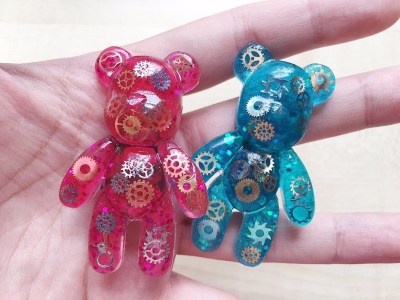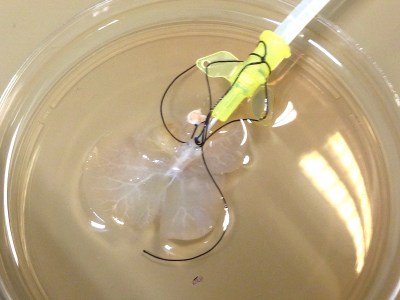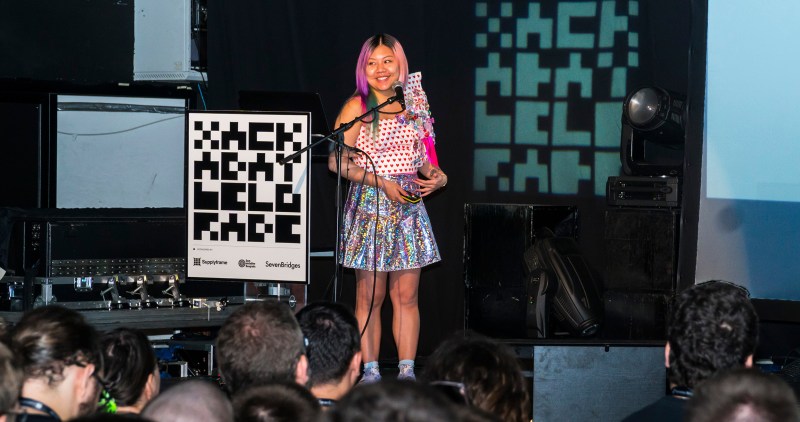The keynote speaker at the Hackaday Belgrade conference was Rachel “Konichiwakitty” Wong presenting Jack of All Trades, Master of One. Her story is one that will be very familiar to anyone in the Hackaday community. A high achiever in her field of study, Rachel has learned the joy of limiting how much energy she allows herself to expend on work, rounding out her life with recreation in other fascinating areas.
There are two things Rachel is really passionate about in life. In her professional life she is working on her PhD as a stem cell researcher studying blindness and trying to understand the causes of genetic blindness. In her personal life she is exploring wearable technology in a way that makes sense to her and breaks out of what is often seen in practice these days.
Wearables That Create Experience
Rachel makes a really interesting observation about where we are right now with wearables. On the one hand you can find a lot of negativity out there about this branch of technological exploration. On the other hand, the commercial offerings that are available are closely related in design and function with little variety. You’ll more often than not find products that are black, and focused on health technology like counting your steps, or measuring your heart beat.
 Wearable fashion is an opportunity to break out of these confines. Rachel sees it as adding purpose to what we wear in a way that enhances the user’s experience. Knowing the calories burned or your BPM are just magic numbers that don’t have an intuitive value to most of us. Focusing on things that enhance an experience gets out of this trap and it’s more approachable for everyone. Rachel makes the point that we’re all making fashion choices on a daily basis as we clothe ourselves and this just adds to that palette.
Wearable fashion is an opportunity to break out of these confines. Rachel sees it as adding purpose to what we wear in a way that enhances the user’s experience. Knowing the calories burned or your BPM are just magic numbers that don’t have an intuitive value to most of us. Focusing on things that enhance an experience gets out of this trap and it’s more approachable for everyone. Rachel makes the point that we’re all making fashion choices on a daily basis as we clothe ourselves and this just adds to that palette.
The demos for this part of her talk include a floral necklace and a headpiece that also leveraged her jewelry making skills. The necklace uses Neopixel rings and a Raspberry Pi zero to animate soft color changes to the flower petals. It’s not a screen you look at, but an enhancement to something you would already wear. The headpiece does include an LED matrix screen, clutched tightly by Hello Kitty which is an homage to her screen name Konichiwakitty, but keeps the pleasing effects of LED glow under the flowers that make up the majority of the piece.
Rachel’s work in wearables has been widely recognized. She wrote a tutorial for Make magazine about resin casting electronics called Curing Cuteness. Using this process she created Maker Gummi Bears which look fantastic — she was showing them off at the con and you can get a closer look on Hackaday.io and at her Etsy page. Rachel has also received a 2018 Bright Sparks award for her work.
Growing Eyeballs in the Lab
It’s always fascinating to hear how people find their path through life. Rachel shared a really interesting insight into becoming a stem cell scientist. Many of her friends were going off into specialties that focus on studying diseases in search of a groundbreaking cure but to Rachel that didn’t seem like the place where the biggest impact will be made. Even if you cure the disease the organs that were afflicted are often already damaged. Rachel wants to make it possible to create brand new organs that can be swapped out as needed — and that’s already happening. Her area of research involves growing eye tissue in the lab and its use is already in clinical testing.

Stem cells are biological building blocks. If you give them a structure as a guide — called a scaffold — you can build anything you want with them. Once in place, they know what to do and can even specialize. In her case this means becoming light sensitive cells or pigmented eye cells.
The scaffolds themselves are fascinating. They can come from cadavers, plants, or other animals. Before the growing process begins these scaffolds are flushed thoroughly with detergents and enzymes until no DNA or other cells remain. The stem cells are then introduced and begin to grow on the structure. Once transplanted, the patient’s body will dissolve and replace the scaffold. And since there was no DNA or cellular material, other than stem cells from the patient’s own body, the new organ will not be rejected.
There’s even 3D Bioprinting technology at work in this field. It’s much like FDM 3D printers you’re probably familiar with, but these operate in a sterile environments building custom scaffolds and adding stem cells as the printing progresses. Rachel isn’t using this printing technology in her research though. In fact she considers her team lucky as they are able to grow the optic cups without need of scaffold at all.
Bring Balance to Your Life
The closing remarks on this keynote are quite powerful. Rachel has had a laser focus on her goals as she worked her way through school. The research she’s doing feels incredibly important — think of the power thaat stem cell scientists have to make people’s lives better — but only if that breakthrough can be reached.
The problem is, without balance in her life this wasn’t sustainable. It’s refreshing to hear Rachel speak candidly about her story and about bringing a cycle of work and recreation into her routine. Now, after a day of rigorous research, she goes home and changes over to her life of making wearables. It’s exercise for her creative side and a different way to stretch her mind that lets her feel refreshed when it’s time to start things again the next day. Carry this advice with you and put it to use when you’re feeling like life has become a grind.
















“Her area of research involves growing eye tissue in the lab and its use is already in clinical testing.”
Still a reach for a complete organ as complicated as an eyeball.
“I don’t know such stuff. I just do eyes. just eyes.”
Hehe, that was my first thought, too :)
It’s worth noting that we still don’t have good control over differentiation of stem cells into every tissue. There are numerous ways to induce differentiation, and they aren’t necessarily mutually exclusive. Common methods include chemical treatments and providing scaffolds/mechanical cues. Chemical methods often involve administering inhibitors of parts of cellular signalling pathways, which have enormously complex downstream effects.
Many types of tissues derived from stem cells via purely chemical means come out a little… wonky. For example, you can try to make cardiac (heart) tissue from stem cells. But the resultant tissue consists of a variety of cells: cardiac muscle (broadly, three kinds: atrial, ventricular, and nodal), fibroblasts (the cells that make up scar tissue), and endothelial cells (the cells that line the inside of blood vessels). Furthermore, the muscle cells (called myocytes) are immature. They look like fetal heart tissue. They don’t metabolize things properly, they have a weird distribution of surface receptors and ion channels, and can’t really generate the force that adult cardiac myocytes can. There are other abnormalities too.
People have tried to use mechanical methods to make them more mature. For example, growing them in crude scaffolds of varying shapes and materials. They get better, but they still aren’t perfect.
Punchline: biology is complex, man.
But bioprinting is a great technology that enables constructing scaffolds with unique geometries, as well as seeding of specific cell types in specific places. Super cool.
The structure of tissues and the stresses they’re subjected to during development play a key role in everything turning out just right.
It’s exciting!
Source: have a good bit of experience with differentiating stem cells (specifically induced-pluripotent stem cells) into cardiac tissue.
Interesting! Thanks!
Instead of trying to make heart scaffolds that exactly copy a natural organ, how about making a simplified yet improved design which eliminates things that cause trouble over time. Natural hearts have many odd nooks and crannies in their chambers that can cause stagnation and clotting of blood when the organ weakens. Some people have naturally extra kinky arteries and veins in their hearts that with age cause constrictions even without plaque buildup.
An optimized heart could have very smooth inside surfaces and blood vessels shaped to provide optimal flow as they branch out to capillaries. How about “The 100 Year Heart” as a goal? Design a human heart able to beat for 100 years.
Is a four chamber design optimal? Could dividing the load among more chambers reduce stress on the heart?
Nature already have designs able to work for more than 100 years (120+ for humans) so the limit should be set higher IMHO.
But it’s probably a case of walking before running, being able to construct a human heart using the natural construction methods is already a great step.
weird dress.
Beauty is in the “eye” of the beholder.
B^)
Boo! :)
She looks great, and it’s not relevant anyway.
If that’s not relevant* why do you think your opinion would be?
(* which it of course isn’t)
The eye is quite a complicated organ, to grow a complete working eye would essentially cure many forms of blindness
not due to genetics. Retrolental Fibroplasia/Retinopathy of Prematurity would be one I can think of off the bat.
“would be one I can think of off the bat.”
Many bats actually have good vision.
B^)
And localized gene manipulation could cure other forms, right?
Waiting for Rachel Wong’s Hello Kitty Human Optical Nueral Computer Interface grow at home kit. Good stuff at around 19:50 but some goofus messed the focus for a part of it. Somebody at HAD should get that woman a few microcontrollers. Pi excessive. Cutest bio-hacker to date. Inexplicably need blueman group/ Venus Hum mvid right now.
“Pi excessive.”
Sir, are you suggesting that one can have too many Pi’s?
That is akin to saying a carpenter can have too many clamps, a photographer can have too many lenses or cameras, fisherman too many lures, or a Electronic Tech can have too many power supplies, is it not?
Preposterous!
No, never enough Pi or any of SBC. To assert otherwise would be ludicrous. snicker. Not a quantity thing. More of a wasted time and resource thing. Takes a while to set up a Raspberry Pi (zero). The Pi Zero seldom found at 5$us and always extra$ needed. Largish form factor comparatively to several microCon. Wearables tech leans toward smaller forms.
Somewhat a power piggy but can be cut down. Though I’ve never reached 30ma that some claim. Other factors avoided for brevity. Ma’m.